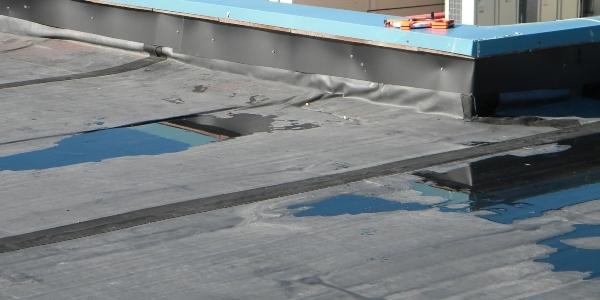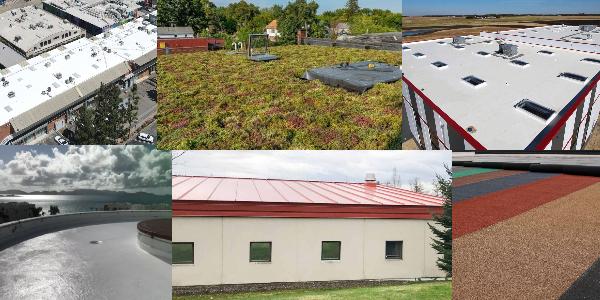Protect Your Industrial Investment

By Western Colloid.
What kind of roofing system is the best for your building? How long should you wait to replace an industrial roof? Get all of your questions answered here.
When you first moved your business into an industrial building, you may or may not have been thinking about the building maintenance, especially the roofing maintenance, that comes along with it. However, if you want to protect your investment and all of the valuable equipment, products and inventory inside, you need to keep your facility in good condition.
Maintaining your roof is one of the most critical components to keeping your building in good repair. Roofs are exposed to the elements, from wind to rain to UV rays from the sun, on a daily basis. Regular inspections are needed to keep the water out and your investments inside safe.
A good roof should only need to be replaced or updated every 10–20 years. This means that a lot has probably changed, in terms of roofing systems, since the last time your roof was replaced. It’s easy enough to replace what’s already there with the same thing, but sometimes this can be costly if all the old material has to be removed.
Before you decide on a new roof system for your building, take a minute to look at the different options available and what will work best for your building. Because the majority of industrial buildings are flat or low-slope, we will focus on those options.
Preserve what you already have
If your existing roofing system is beginning to show signs of aging and you want to be proactive and preserve what you have, a coating system may postpone your roof replacement for 10+ years. Roof coatings come in many different qualities and varying life expectancies, so it’s important to choose a reputable manufacturer with a proven track record.
If your roof is leaking, but still structurally sound with little moisture content, you have several options for overlay systems. Because of weight concerns, you cannot do all overlay systems if you already have two roofs installed. Your only possible option at that point is to do a Fluid Applied Reinforced Roofing System or FARR.
A FARR system involves one or more layers of fluid roof coating, reinforced with polyester fabric. The result is a flexible, durable and environmentally friendly solution that can significantly extend the lifespan of your roof.
The many layers of coating and fabric create redundancy in your waterproofing, so even if one layer is damaged, water will not penetrate through the other layers, and leaks can easily be repaired.
More information on FARR systems is provided in the discussion of roof overlays below.
Tear-off and replace
If your roof has moisture damage to a large portion of the deck and the structure is beginning to fail, a tear-off and replacement job may be needed.
Let’s start with the worst-case scenario. Your roof’s structure has been compromised and a qualified roofing consultant or contractor has determined that a complete tear-off and replacement is the only option.
The good news is that if you are tearing your roof off, you’re not restricted as to what goes back on. However, you will have to make sure your roof complies with all new codes including energy requirements. This can involve:
-
Upgrading your insulation for R-Value.
-
Potential modifications to your existing parapet wall heights and equipment curbs to accommodate the additional insulation.
-
Additional expenses to modify the utilities through the roof assembly to service those units.
If a complete tear-off and replacement becomes necessary, here are some options to consider.
Single-ply
Single-ply roofs have gained popularity partly because of the ease of installation. Insulation and cover board go down first and then rolls of the roofing are laid out, and either seamed, heat welded, mechanically attached or fully adhered. Some are even ballasted with rock or pavers as a means of attachment.
There are many variables that must be considered when designing these systems so no one method fits all roofs. Two systems in the single-ply category are thermoplastics and thermosets.
Thermoplastics
Thermoplastic roofs are durable, relatively lightweight, flexible and cost-effective. As a plastic, they are waterproof, and all can help manage your building’s energy efficiency. Thermoplastic roof systems are typically made from Thermoplastic Olefin (TPO) or Polyvinyl Chlorine (PVC).
TPO seems to be the more popular system and is known for being economical up front; it’s been on the market since the 1990s. However, thermoplastics are defined by their ability to change shape as they are heated, and this becomes a potential problem for TPO roofs in extreme sun conditions. Buildings in the southern United States will need to consider regional climate conditions when considering a TPO roof.
The good news is, as a relatively new product, TPO manufacturers continue to modify their formulations to try and achieve the required level of performance, and so product quality continues to improve.
An older alternative, available and performing well since the 1960s, is PVC roof systems, also called ethylene and chlorine roofs. PVC has good chemical resistance and flexibility, but older PVC roofs have a tendency to shrink in cold weather. As a result, the National Roofing Contractors Association recommends no foot traffic on PVC roofs in weather colder than 50 degrees.
Thermosets
Also an older plastic option, Ethylene Proplyene Diene Monomer (more commonly called EPDM) or synthetic rubber roof systems are durable and offer good heat and fire resistance.
The one major disadvantage to EPDM systems is they are most commonly black in color, meaning they will retain heat and, as such, may be a better choice for cooler climates. As more and more jurisdictions implement legislation to require or incentivize cool roofs, black roofs like EPDM may become less popular.
Built-up roofs and modified bitumen roofs
Built-up roof (BUR) membranes are the oldest and toughest roofing systems still being used. Your roofing contractor builds on your roof alternating layers of bitumen and reinforcing fabrics that create a finished membrane. A “four-ply” BUR has four layers of bitumen and fabric and is topped with gravel, slag or mineral granules, glass-fiber or mineral surfaced cap sheets.
In some installations, a base sheet may be used at the bottom ply and mechanically fastened to the roof deck, and in others, they are applied directly to the roof deck and are fully adhered. BURs are known to be a costlier option upfront but, in general, have the best long-term performance.
Modified bitumen, or mod-bit, roof systems are a modernized BUR adaptation. Mod-bit is a roofing sheet membrane that is fabricated in a factory and consists of asphalt and plastic or rubber polymers. They may be installed by the torch-application method, hot asphalt like BUR, or applied with cold-process adhesives. The latest innovation is the self-adhering sheet.
Both BUR and mod-bit roof systems are known for their durability but can be more susceptible to water damage than some of their thermoplastic and thermoset counterparts. This is especially true on flat roofs prone to ponding. If water collects and sits on a bitumen or mod-bit roof, it will degrade the material.
Although these roofs have been an industry standard for decades, they have lost some popularity thanks to the cool roofing trend. However, a building owner or operator looking for BUR’s or mod-bit’s proven track record, while still managing energy costs, can convert their roof system to a cool roof with a fluid applied application on top.
Metal
The right metal roof can be a long-lasting and low-maintenance option. Metals used in roofing are most commonly galvanized steel or aluminum.
Galvanized steel is one of the hardier and more economical options. Galvanized steel panels offer a lot of flexibility in design and color: They can be finished in such a way as to mimic copper, zinc or weathered steel.
Aluminum is often the better choice for coastal climates where corrosion from the salt air is a concern. Aluminum has greater strength than steel but also has a higher price point; plus, the sheets are often thinner in order to reduce costs.
Overlay
An alternative to a complete tear off is an overlay, which goes over your existing system. Make sure to speak with your contractor about the system they’re proposing and its durability, longevity and compatibility with the existing roof system below. Installing an overlay on top of an incompatible roof system has the potential to void your manufacturer’s warranty.
Overlay options tend to be more cost effective than a complete tear off and also faster to apply. Most of these systems are low VOC and low odor, making them a good choice for occupied buildings where you don’t want to deal with occupant complaints about indoor air quality while contractors are working.
There are many overlay systems available, including some of the systems discussed above, like single-ply. There are, however, a number of new modern options that provide good longevity and durability, while also offering improvements in energy efficiency.
Fluid applied reinforced roofing
Fluid Applied Reinforced Roofing (FARR) is incredibly versatile. It was specifically designed to be economical as overlays and is compatible with all of the above-mentioned roofing systems, while also being lightweight enough that it can be applied on top of two existing roof systems without impacting your building’s structure.
FARRs are essentially roof coatings, combined with polyester fabric for strength and flexibility and layered in a BUR manner. Many of these systems have warranties comparable to the traditional membrane already on your roof. FARR systems are puncture resistant, energy efficient, low VOC, self-adhering, monolithic roofing systems. This system will protect your existing roof from UV degradation and lengthen its lifespan significantly.
There are many variables that determine which FARR system is right for your roof, including:
-
Existing roof substrate
-
Ponding water issues
-
Size of the roof and roof access conditions
-
Project budget
-
Desired warranty length
There are two basic FARR systems: asphalt emulsion-based systems and acrylic systems.
Asphalt emulsion-based systems
Asphalt emulsion is elastomeric by nature and an excellent waterproofing compound when applied at the proper thickness. It is also very economical, making it practical for building up a thicker base for the membrane, as it adheres well to many surfaces that other products may not.
In a Fluid Applied Reinforced Roof, asphalt emulsion is layered with polyester fabric for strength and flexibility, and then top coated with elastomeric acrylic coatings such as Elastahyde to not only protect the asphalt emulsion on polyester from UV degradation, but to add reflectivity and energy efficiency.
All acrylic systems
All acrylic FARR systems are the same basic concept as the asphalt emulsion systems but with acrylic coating as the base coat under the polyester membrane. Because most acrylic systems are white in color, they’re a good option for energy conservation.
Final thoughts
A new roof is a major investment, both in terms of time and money. It’s important to ensure you are choosing the right roof system for your building to avoid wasting money and potentially making your roof problems worse.
To strike the right balance between budget, scheduling, ongoing maintenance and energy efficiency, contact Western Colloid to discuss options that suit your project.
Learn more about Western Colloid in their RoofersCoffeeShop® Directory or visit www.westerncolloid.com.
Original article source: Western Colloid










Comments
Leave a Reply
Have an account? Login to leave a comment!
Sign In